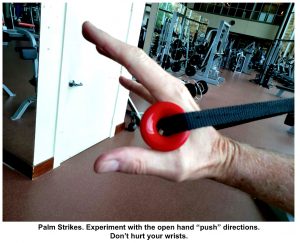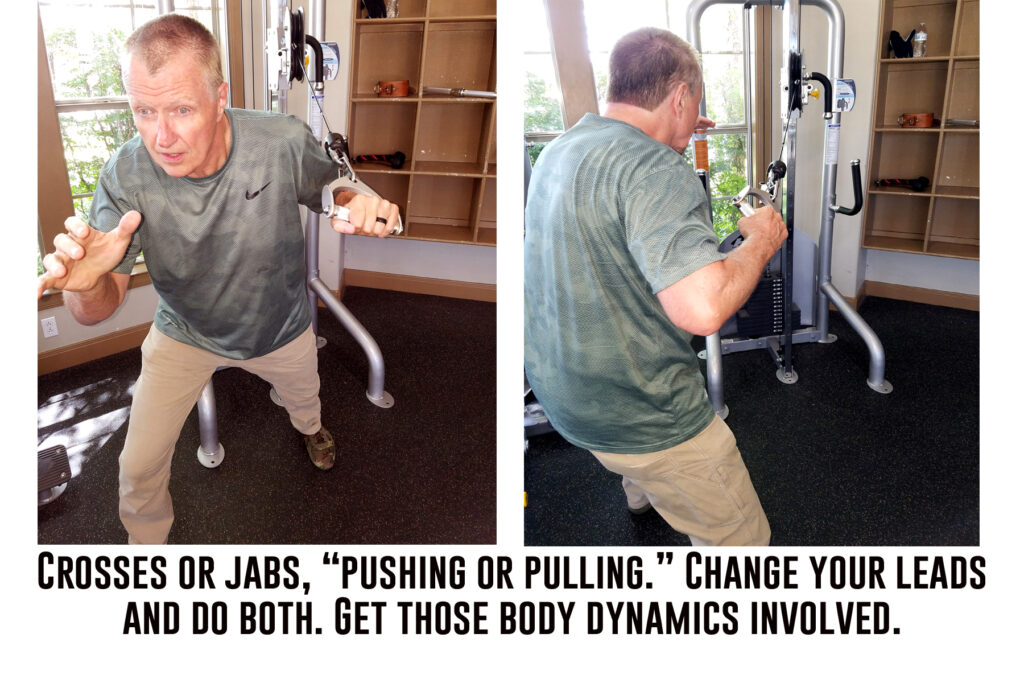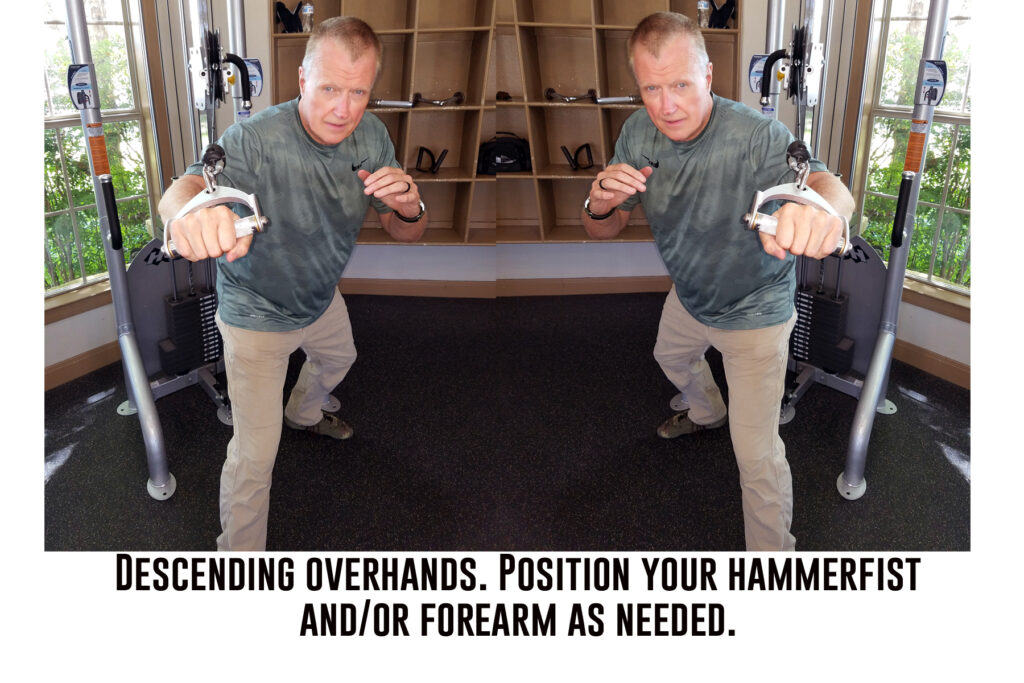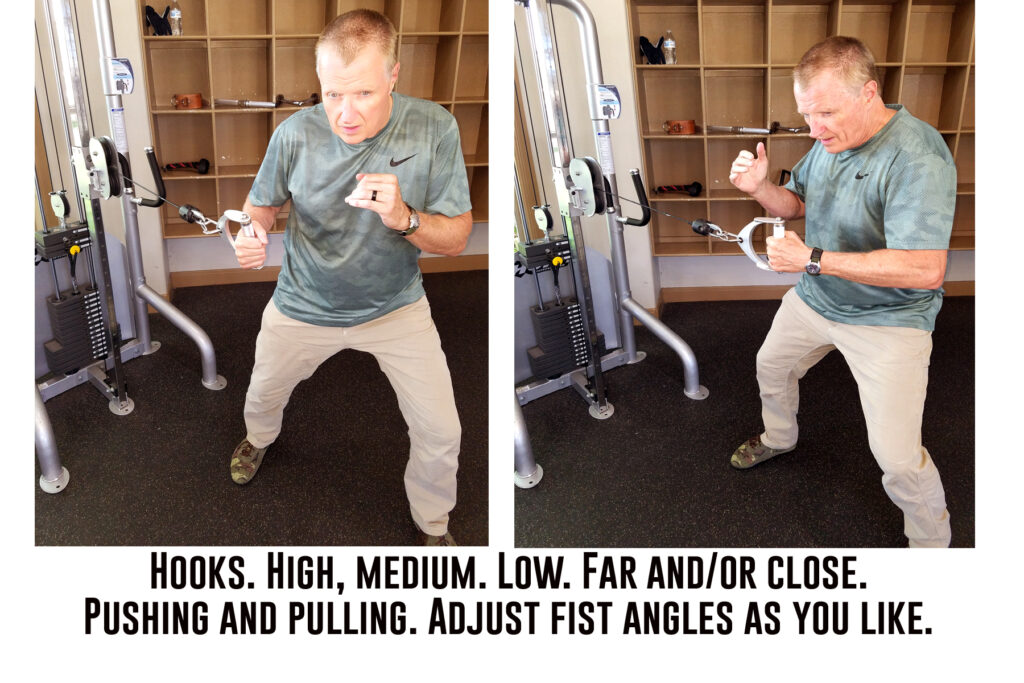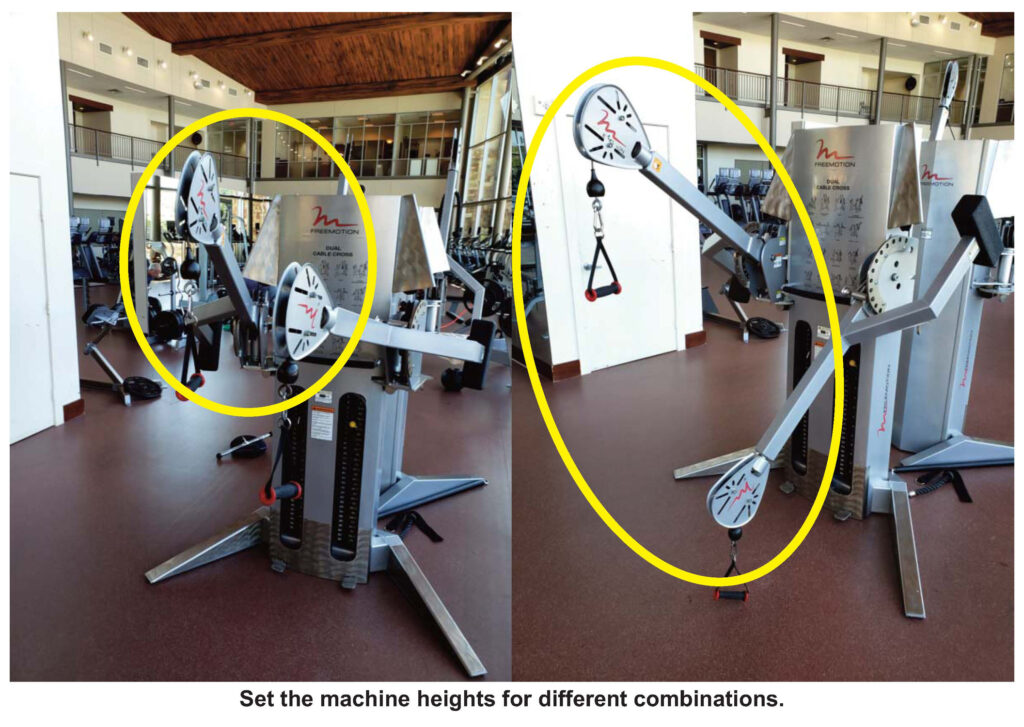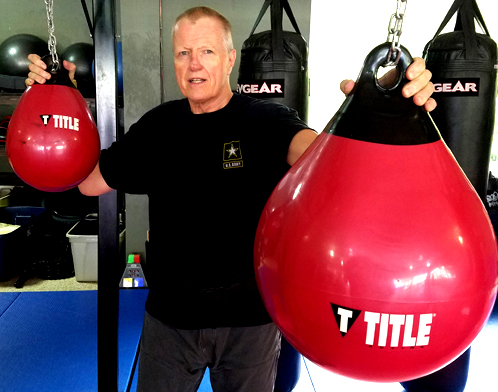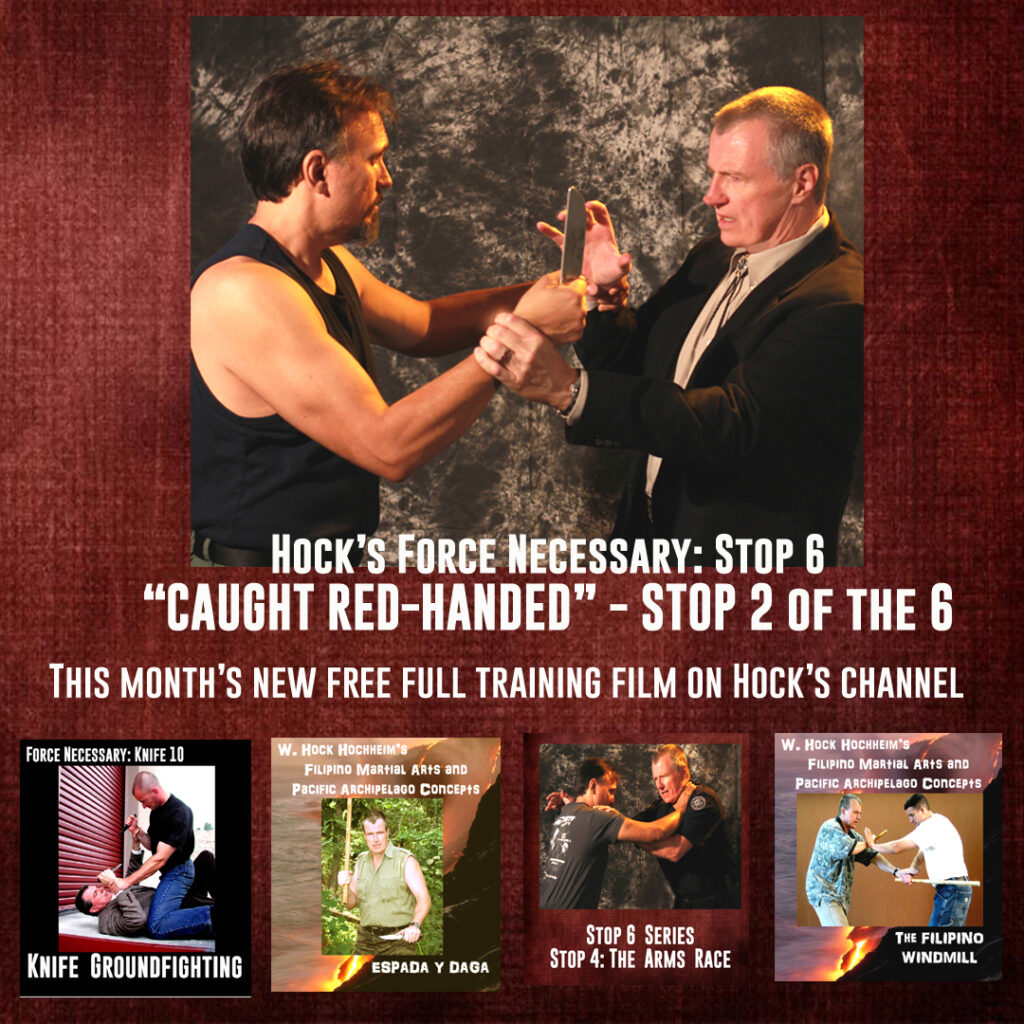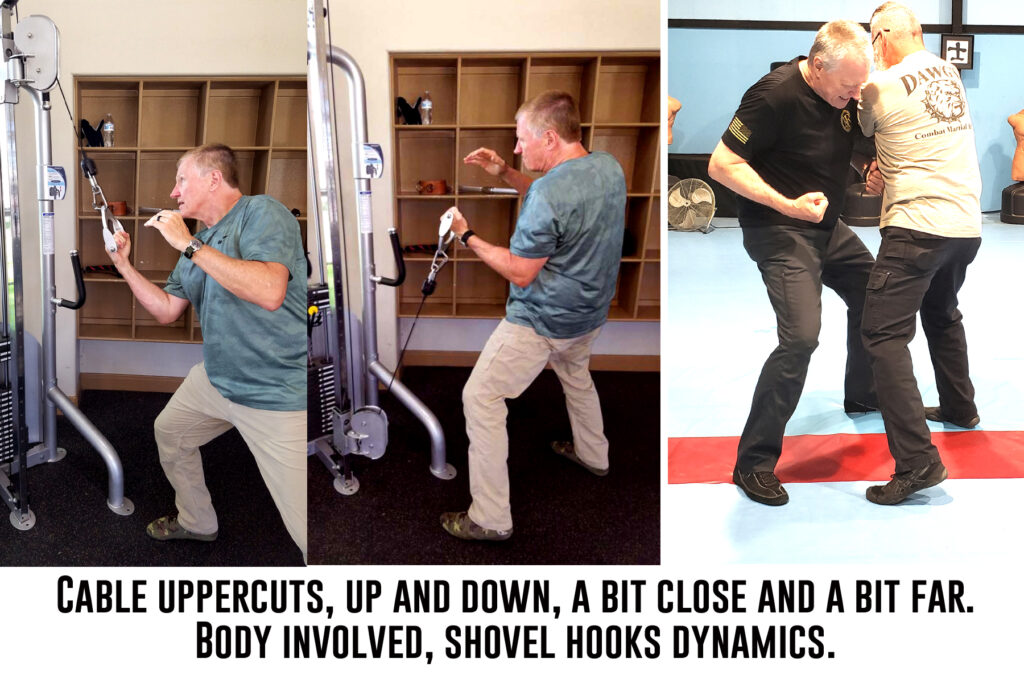
A few years back I taught a seminar at Doc Sheldon’s Private Training Center in the Cincinnati, Ohio area. The place is loaded with equipment and I saw a cable machine. As an aside from my outline, I showed some folks the workout I’ve never stopped doing with cables since the 1980’s, that I thought was fairly common idea and knowledge. But no. Others surrounded us and no one there had seen it before and they found it inspiring. So for the record, here it is.
We all know the big five, generic standing through ground, essential punches:
- Jab (high, medium, low, close, far.)
- Cross (high, medium, low, close far.)
- Hook (high, medium, low.)
- Uppercut (landing high, medium, low, close, far.)
- Overhand or descending overhand (usually starts high and…yes – descends, thus the name. Your strike could be a hammerfist on up to forearms.
I guess some folks know about the versions of each punch? But I suspect some just punch. Yet, each one has a height and distance-range to practice. Landing high. Landing medium. Landing low. A bit far and very close as in grappling range. (Ground punching is similar, but of course a bit different. This essay is about standing only.)
There were eras in the US military that they never taught an official jab or official cross, but rather just called them “right punch” or “left punch.” They thought that shoulder and foot positions weren’t important or very situational and uncontrollable from movement. Do you step-walk in and out, side-to side? Or shuffle foot, maintaining a lead? Other than voluntary, classic boxing in the military police academy -which I did and they did adhere to jabs and crosses, the early 70s army combatives we did and just right and left punched, no matter where are feet were. I however have always seen a difference and used the training concepts of the Jab – the foot/shoulder forward, and the Cross – rear foot/rear shoulder. I still see the need for such isolated practice.
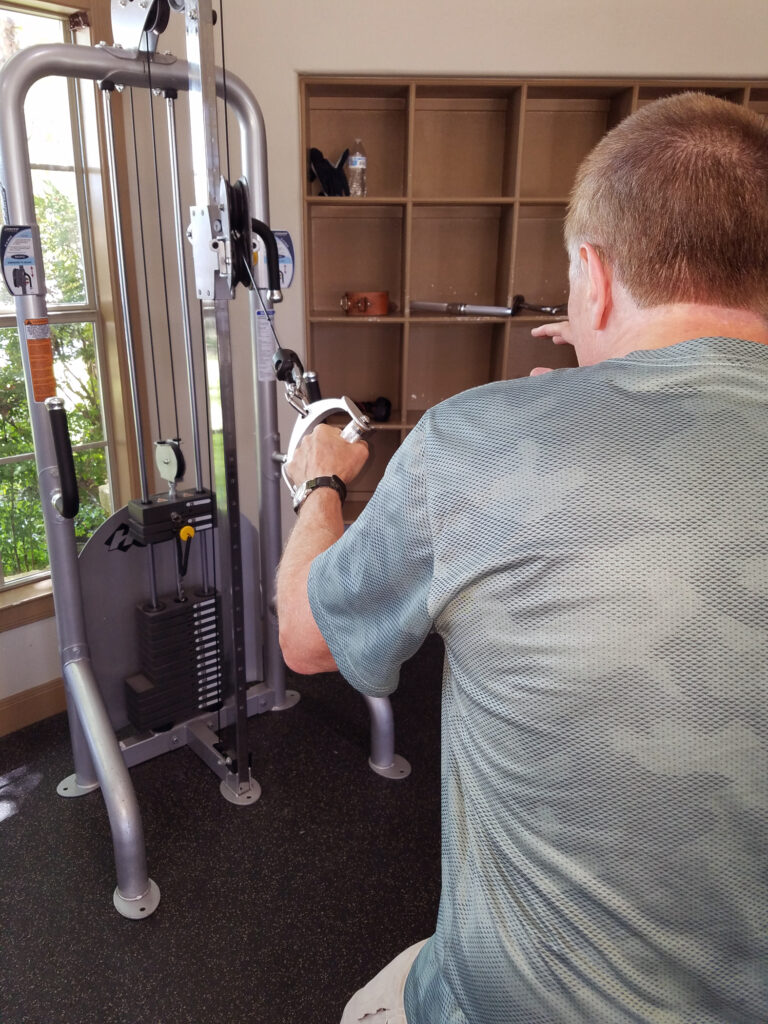
Technically on a cable machine, you are always pulling the cable weights up the “tower” of the machine. But you can push and pull on your end of the cable. To define this particular exercise process I explain that when you stand facing the machine, the cable is pulling you into it, pulling your hand into the machine. When you are facing away from the machine, you are pushing the handle away from the machine. This is how I like to define the exercises for clarity. Push-Pull. Face-away, push. Face in, pull. Facing in and turning away can create the give and take needed training for punching.
I would like to add quickly that you can use these same cable machine methods with palm strikes for all you anti-punchers out there. But only in the “pushing outward” method, unless you closely monitor the handle on the outside of your hand? (Does the handle roll?) Otherwise, you have to close your hand to grip the handle with facing in to the machine. Don’t hyperextend your wrist. Use reasonable weights. Do emphasize the palm heel as much as possible. It’s part of your weapon resume.
If you shadowbox with hand weights – yes – you are abstractly building the path for punching. Abstract because you have to remember that your hand, arm and shoulder are battling up-and-down gravity with that hand weight. The more weight, the more you are building/fighting up-and-down, vertical gravity and building those related up-down muscles. With a cable machine there is no up/down gravity, just the machine pivot point behind or in front of you at the prescribed height. Some people shadow box with mere 1 or 2 pound weights and this is so light there is not much “gravity” fighting at all. But more hand weight? You are losing goal, effectiveness. So, are you vertical building or horizontal building? Horizontal is more on-mission, unless of course, you are uppercutting or doing low origin shovel hooks to say- the groin. 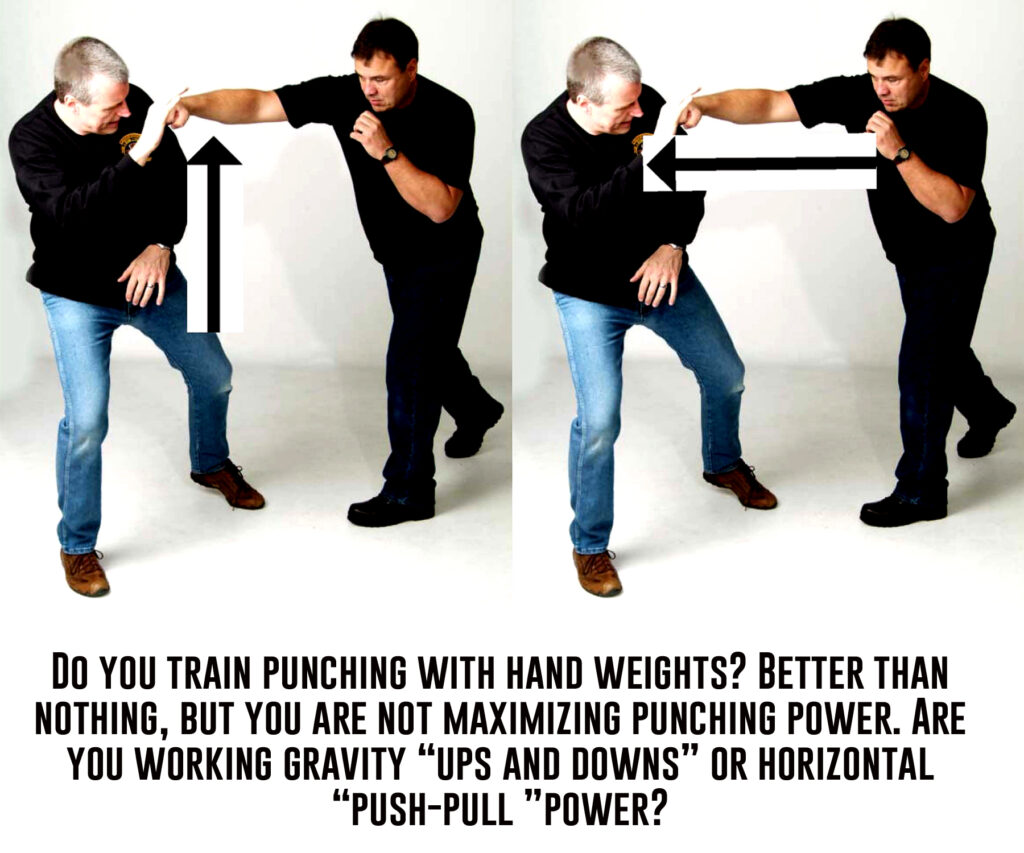
Conan? Arnold? No, you won’t get Conan muscles doing these cable exercises. But I think this method develops striking power and speed. I do reps with each strike listed below, when this series comes up in my rotation, which can be once or twice a week (for 40 years give or take sickness, medical operations, and travel). It takes about 20 minutes of non-stop motion. The next day my arms are very sore and my lower back muscles – with all the torso twisting, are sore. Depending on the cable punch, it involves many body muscles. It can be aerobic and if you switch your feet a lot, it adds to workout.
People like to do various exercises with those big rubber bands, but they can be limiting in height and range when attempting all the listed strikes, and you have to hook them onto something! Will the hook be the right height? How? Meanwhile, the ubiquitous cable machine will offer the range and the height and quick-change resistance.
With this advice, I stand facing the machine and facing away, back to the machine. I do not do these with heavy plates, but you can build up to anything you want, I guess. Just try to remember:
- 1- Don’t hurt your wrists!
- 2- Whether punches or palm strikes get the right positioning for your hand, the best hand-to-handle position. When punching, try to get your knuckles involved in the pulling and pushing. When palm striking, try to get your palm heel involved in the pushing. (You can’t face the machine and “pull” the palm strike because your hand is open.
- 3- Always try to keep your free hand up and open. Don’t get sloppy and let that other hand drop.
- 4- Keep your mouth closed, teeth together as a matter of routine. You can still expel “martial” air. This practice helps you avoid the broken jaw in reality bare-knuckle fights.
- 5- The martial cable machine workout will involve other body parts, which is a good overall thing, but can surprise the “great unwashed.”
Now, for some exercise suggestions
The Jab and Cross (Punch or Palm) Set the pivot height at shoulder length, face away from the machine and do-
- A set of right jabs pushing the handle.
- A set of left hand jabs pushing the handle.
- A set of right crosses pushing handle.
- A set of left hand crosses pushing the handle.
- Try some bent-arm low punches, “thrusting gut” punches too. They seem to get ignored. Set the pivot point gear low and do them.
Descending Overhand (Punch or Palm)
- A set of right overhands pushing handle.
- A set of left hand overhands pushing the handle.
- A set of right cross overhands pushing handle.
- A set of left hand crosses overhands pushing the handle.
- A set of right overhands pushing handle with a slight hook.
- A set of left hand overhands pushing the handle with a slight hook.
- A set of right cross overhands pushing handle with a slight hook.
- A set of left hand crosses overhands pushing the handle with a slight hook.
- Add a slight hook to this and this exercise helps with a very popular and successful MMA style strike. You may have to reduce the weight a bit as the wrist goes a little funky with the turn and slight hook. Experiment with the weight.
Hooks (Punch or Palm) (High Hooks or Low Hooks)
- A set of right hooks pushing the weights.
- A set of right hooks pulling the weights.
- A set of left hooks pushing the weights.
- A set of left hooks pulling the weights.
- (You can use a lot of footwork doing these)
Uppercuts (Punch or Palm)
- A set of right uppercuts pushing the weights.
- A set of right uppercuts pulling the weights.
- A set of left uppercuts pushing the weights.
- A set of left uppercuts pulling the weights.
- (You can use a lot of footwork doing these)

Combinations (Punch or Palm)
Set the gear-pulley-pivot points at:
- various distances apart.
- various heights.
- invent combinations of the above, in both push/pull directions!
- you can also do hammer fists if you can get the right handle and cable.
Kicks? You ask? Yes. I did not photograph them here because I quit doing them in my mid-40s. No matter how light I set the weights I began to have back problems every time I did them. I hated that. But pain is pain. Cable machines also have straps for your ankles and the rest of your legs. You can also rig yourself up for cable, kick (and knee) work. Through the years I have done snapping, hooking kicks/knees with cable machines. But, as I have gotten older with bad hips and deteriorating backbone discs, I can no longer do these under the cable weights without follow-up pain. Anyway, this essay is just about striking.
Some other points:
- Of course you should still hit bags, etc. As I have aged, hitting things that don’t give-way (and I don’t wear big boxing gloves, nor wrap my wrists, as I don’t want to become dependent upon them) cause me follow-up wrist, shoulder or back pain. There are various pieces of equipment that “give” sufficiently. Like these water-based bags.
“That guy is not following muscle building structures!” You will be looked at by gym trainers as unsafe, uncool and crazy. But after you start doing the uppercuts, blowin’ and goin’, changing footwork with each punch, they tend to leave you alone. In this vein, I am sure there will be a fitness guru here that responds to this essay and tells people I am killing your “Arnold” physique with these ideas. After all, we are on-mission, functional, self defense, survival fighters.
As usual, as natural, you will do this and get over-confident and keep adding the weight plates. More, more, then more. Then you will hurt yourself. Then you will heal, recoup, rebuild, add, add again, get over confident, hurt yourself again, heal, recoup…rehurt….you get the picture. This is the life we have chosen. This is the lifetime routine. Get use to it or die fat and out of shape.
These exercises have been very beneficial to me. It’s one more thing I can do in a typical, solo gym workout that leans toward functionality. Some of you may be doing these your whole life too? But I thought I would write this for:
- those who are new at this,
- those who won’t do them,
- those who didn’t care to before and might try it now,
- those who “say” they do them, but not often or as completely,
- or for folks who’ve never thought of it.
MORE! Australia’s Peter Sciarra on using cable for knee strikes Click here
+++++++++++++
Hock’s email is Hock@HocksCQC.com
Many free, one-hour training films are on Hock’s TV channel. Watch them, click here.
